Use of a Convolutional Neural Network for Predicting Fuel Consumption of an Agricultural Tractor
Abstract
1. Introduction
2. Materials and Methods
2.1. Equipment
2.2. Field Experiments
2.3. Neural Network Design
2.4. Data Used in the Designed CNN
3. Results and Discussion
3.1. Temporal Fuel Consumption
3.2. Specific Fuel Consumption
4. Conclusions
Author Contributions
Funding
Institutional Review Board Statement
Informed Consent Statement
Data Availability Statement
Conflicts of Interest
References
- Šmerda, T.; Čupera, J. Tire inflation and its influence on drawbar characteristics and performance–Energetic indicators of a tractor set. J. Terramech. 2010, 47, 395–400. [Google Scholar] [CrossRef]
- Elwaleed, A.K.; Yahya, A.; Zohadie, M.; Ahmad, D.; Kheiralla, A.F. Net traction ratio prediction for high-lug agricultural tyre. J. Terramech. 2006, 43, 119–139. [Google Scholar] [CrossRef]
- Çarman, K.; Taner, A. Prediction of tire tractive performance by using artificial neural networks. Math. Comput. Appl. 2012, 17, 182–192. [Google Scholar] [CrossRef]
- Abed Dhadah, H.; Ahmed Mudheher, H.; Miqdam Tariq, C.; Hussein, A.K. Prognostic of diesel engine emissions and performance based on an intelligent technique for nanoparticle additives. Energy 2022, 238, 121855. [Google Scholar] [CrossRef]
- Mustayen, A.G.M.B.; Rasul, M.G.; Wang, X.; Bhuiya, M.M.K.; Negnevitsky, M.; Hamilton, J. Theoretical and Experimental Analysis of Engine Performance and Emissions Fuelled with Jojoba Biodiesel. Energies 2022, 15, 6282. [Google Scholar] [CrossRef]
- Rahimi-Ajdadi, F.; Abbaspour-Gilandeh, Y. Artificial neural network and stepwise multiple range regression methods for prediction of tractor fuel consumption. Measurement 2011, 44, 2104–2111. [Google Scholar] [CrossRef]
- Almaliki, S.; Alimardani, R.; Omid, M. Artificial neural network based modeling of tractor performance at different field conditions. Agric. Eng. Int. CIGR J. 2016, 18, 262–274. [Google Scholar]
- Igoni, A.H.; Ekemube, R.A.; Nkakini, S.O. Predicting tractor fuel consumption during ridging on a sandy loam soil in a humid tropical climate. J. Eng. Technol. Res. 2019, 11, 29–40. [Google Scholar] [CrossRef]
- Siddique, M.A.A.; Baek, S.-M.; Baek, S.-Y.; Kim, W.-S.; Kim, Y.-S.; Kim, Y.-J.; Lee, D.-H.; Lee, K.-H.; Hwang, J.-Y. Simulation of Fuel Consumption Based on Engine Load Level of a 95 kW Partial Power-Shift Transmission Tractor. Agriculture 2021, 11, 276. [Google Scholar] [CrossRef]
- Kolator, B.A. Modeling of Tractor Fuel Consumption. Energies 2021, 14, 2300. [Google Scholar] [CrossRef]
- LeCun, Y.; Bengio, Y.; Hinton, G. Deep learning. Nature 2015, 521, 436–444. [Google Scholar] [CrossRef]
- Zhang, Z.; Cui, P.; Zhu, W. Deep learning on graphs: A survey. IEEE Trans. Knowl. Data Eng. 2020, 34, 249–270. [Google Scholar] [CrossRef]
- Yao, G.; Lei, T.; Zhong, J. A review of convolutional-neural-network-based action recognition. Pattern Recognit. Lett. 2019, 118, 14–22. [Google Scholar] [CrossRef]
- Dhillon, A.; Verma, G.K. Convolutional neural network: A review of models, methodologies and applications to object detection. Prog. Artif. Intell. 2020, 9, 85–112. [Google Scholar] [CrossRef]
- Chen, Y.; Wei, Y.; Wang, Q.; Chen, F.; Lu, C.; Lei, S. Mapping post-earthquake landslide susceptibility: A U-Net like approach. Remote Sens. 2020, 12, 2767. [Google Scholar] [CrossRef]
- Wang, N.; Chen, F.; Yu, B.; Qin, Y. Segmentation of large-scale remotely sensed images on a Spark platform: A strategy for handling massive image tiles with the MapReduce model. ISPRS J. Photogramm. Remote Sens. 2020, 162, 137–147. [Google Scholar] [CrossRef]
- Tsakiridis, N.L.; Keramaris, K.D.; Theocharis, J.B.; Zalidis, G.C. Simultaneous prediction of soil properties from VNIR-SWIR spectra using a localized multi-channel 1-D convolutional neural network. Geoderma 2020, 367, 114208. [Google Scholar] [CrossRef]
- Zhang, X.; Lin, T.; Xu, J.; Luo, X.; Ying, Y. Deep Spectra: An end-to-end deep learning approach for quantitative spectral analysis. Anal. Chim. Acta 2019, 1058, 48–57. [Google Scholar] [CrossRef]
- Fathollahzadeh, H.; Mobli, H.; Rajabipour, A.; Minaee, S.; Jafari, A.; Tabatabaie, S.M.H. Average and instantaneous fuel consumption of Iranian conventional tractor with mouldboard plow in tillage. ARPN J. Eng. Appl. Sci. 2010, 5, 30–35. [Google Scholar]
- Moitzi, G.; Wagentristl, K.; Refenner, K.; Weingartmann, H.; Piringer, G.; Boxberger, J.; Gronauer, A. Effects of working depth and wheel slip on fuel consumption of selected tillage implements. Agric. Eng. Int. CIGR J. 2014, 16, 182–190. [Google Scholar]
- Küçüksarıyıldız, H.; Çarman, K.; Sabancı, K. Prediction of Specific Fuel Consumption of 60 HP 2WD Tractor Using Artificial Neural Networks. Int. J. Automot. Sci. Technol. 2021, 5, 436–444. [Google Scholar] [CrossRef]


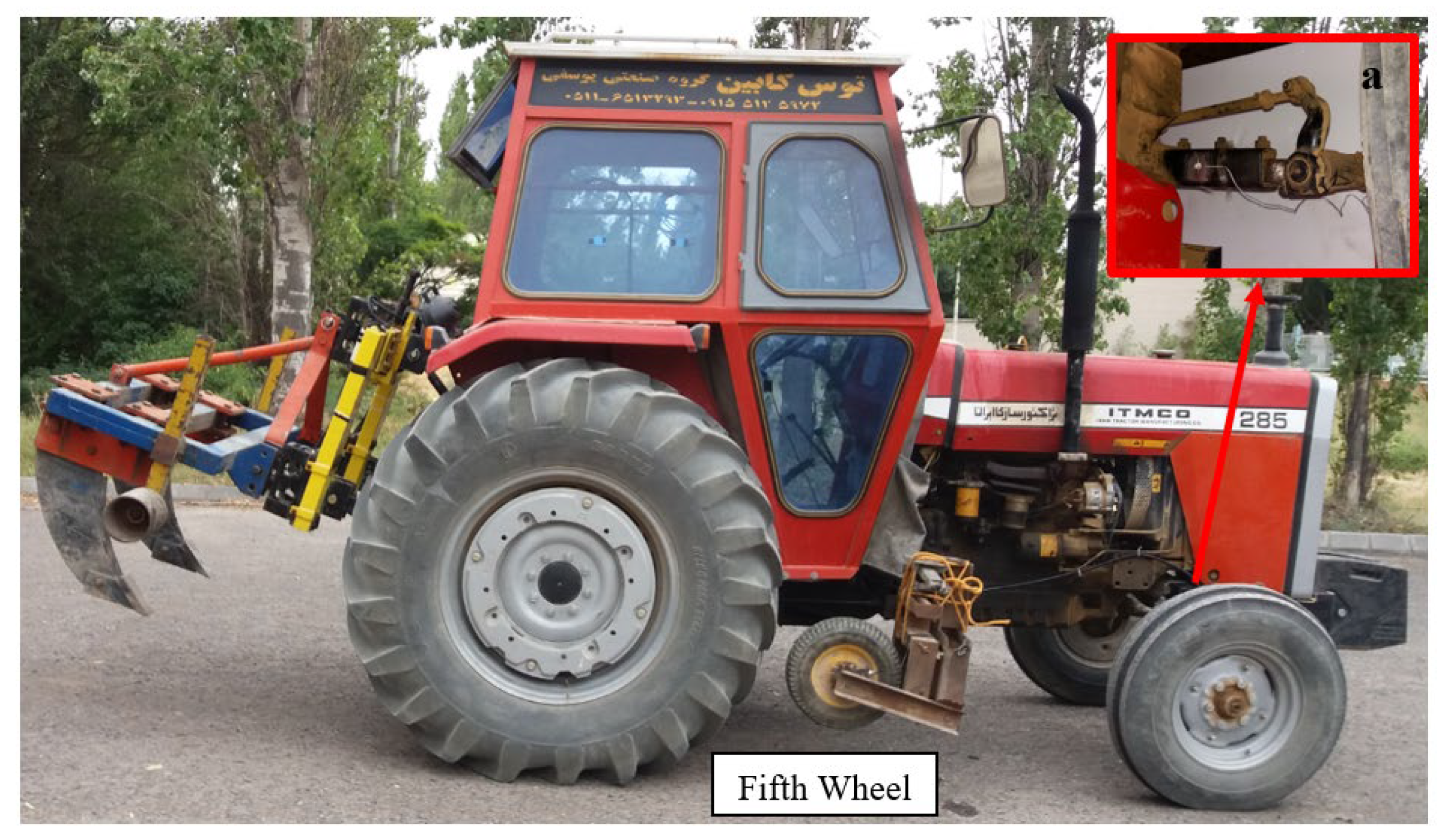


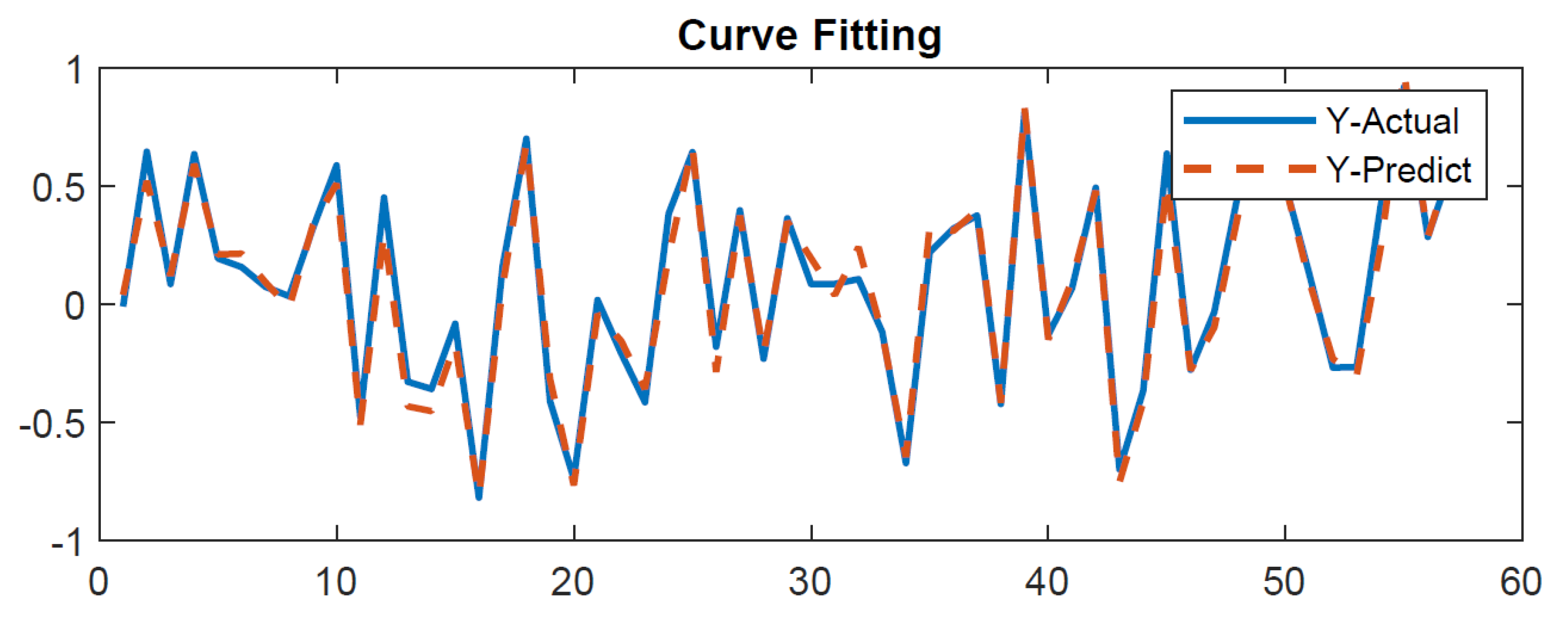
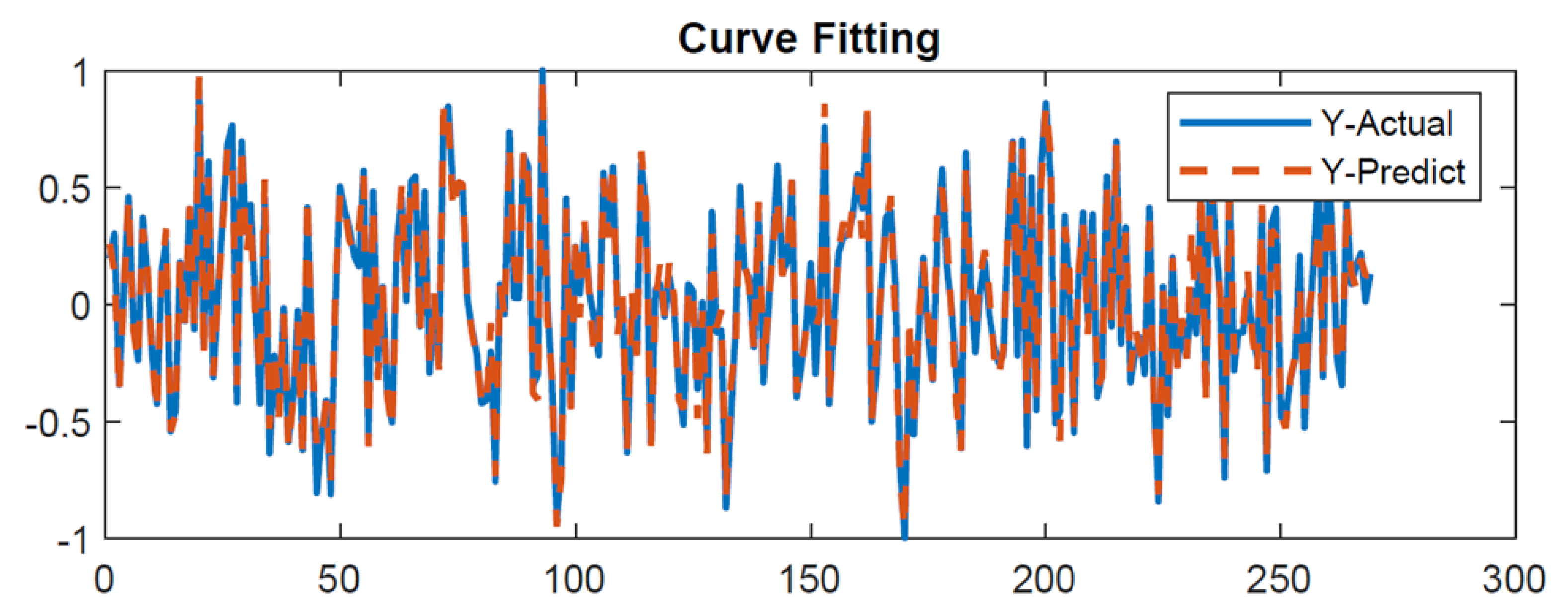
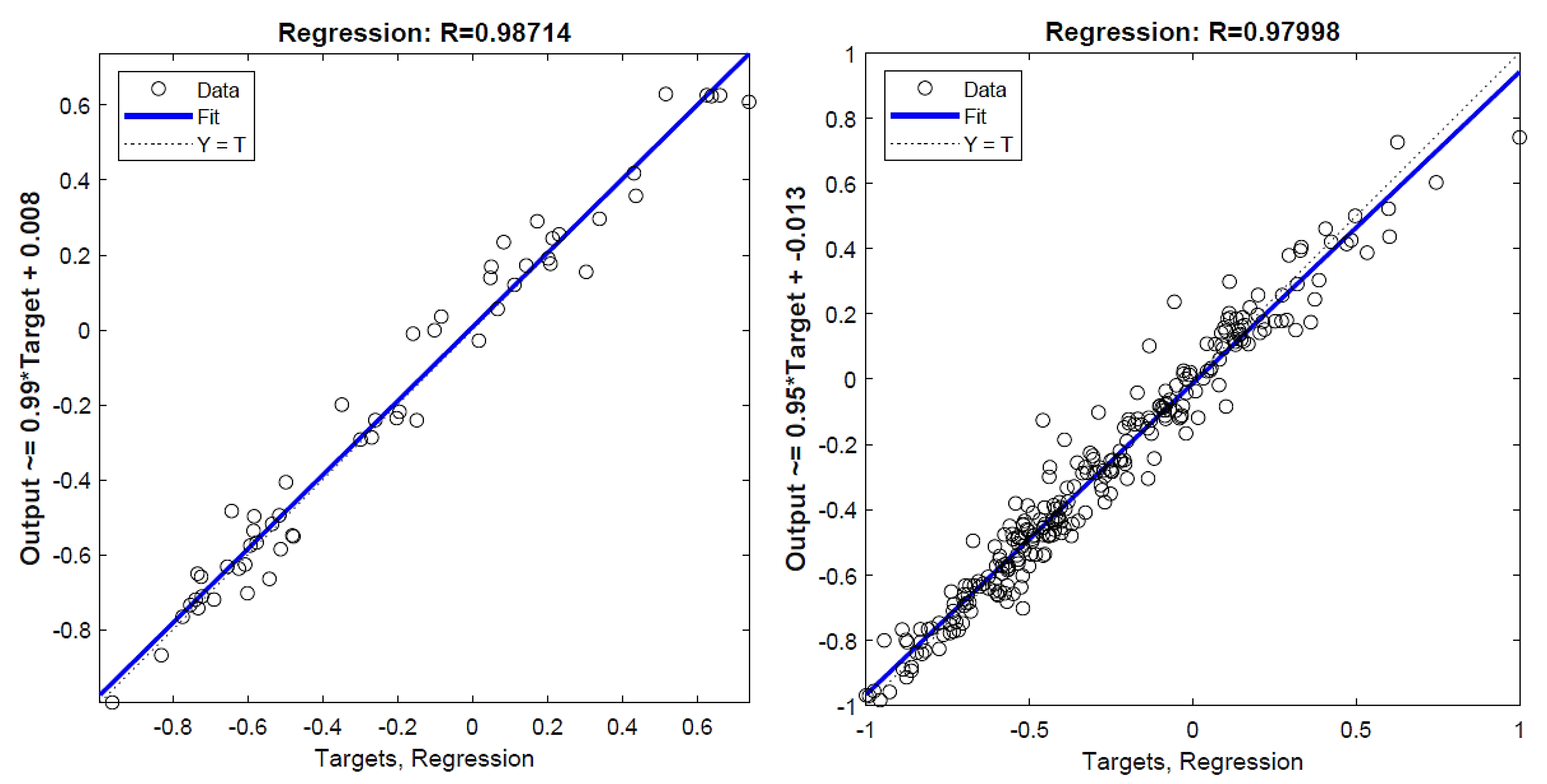

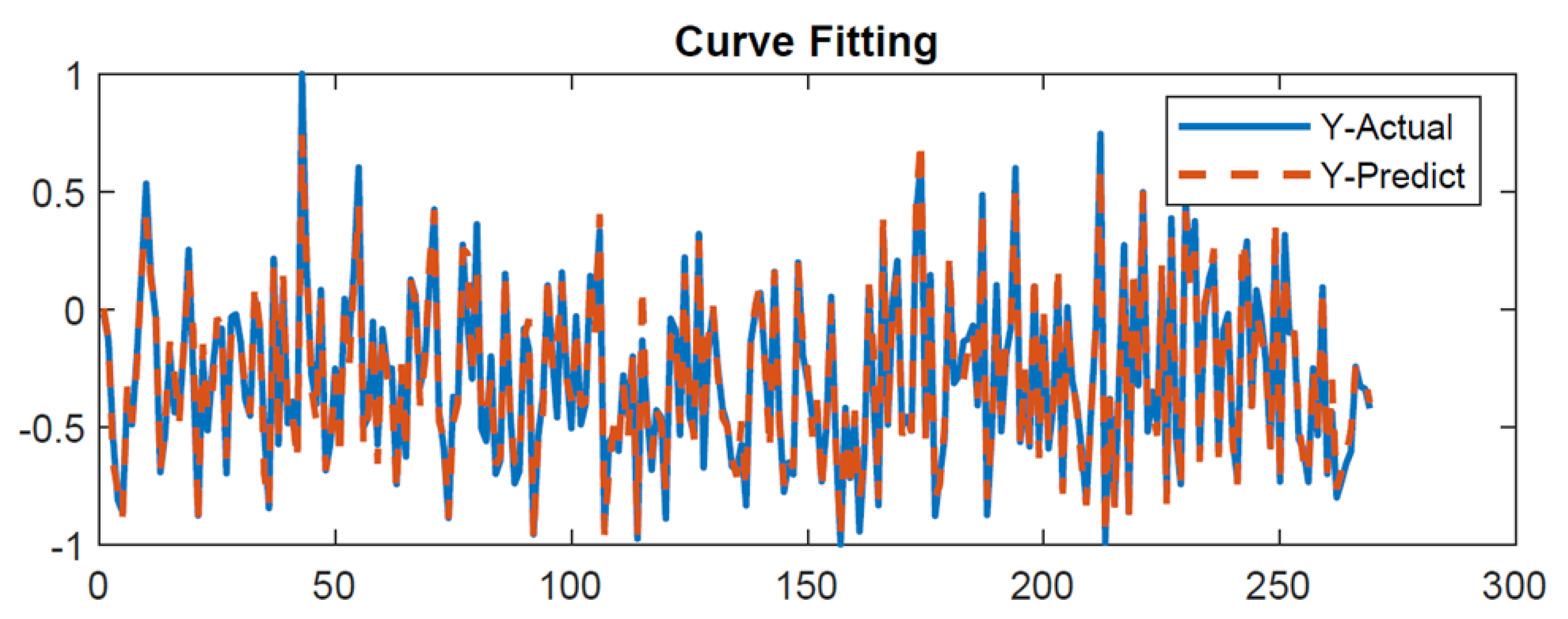
| Item | Parameters |
|---|---|
| Manufacturer | Motor manufacturer’s company |
| Type | Diesel with direct injection |
| Number of cylinders | 4 |
| Compression ratio | 16:1 |
| Firing order1 | 1-3-4-2 |
| Maximum power at 2000 rpm | 75 hp |
| Maximum torque at 1300 rpm | 278 N·m |
| Type of injector pump | Rotary |
| Fuel tank capacity | 90 L |
| Transmission | Gears |
| Lifting capacity | 2227 kg |
| Type of steering system | Mechanical-hydraulic |
| Type of cooling system | Liquid-cooled |
| Type of injector pump | Rotary |
| Distance to the ground | 380 mm |
| Front tire size | 12.4–24 inch |
| Rear tire size | 18.4/15–30 inch |
| Disc weights on the rear wheel | 180 kg |
| Bag weights in front of the tractor | 192 kg |
| Front weight | 1350 kg |
| Rear weight | 1820 kg |
| Total weight | 3170 kg |
| Model | Taka 220 |
|---|---|
| Working width | 1.3 m |
| Maximum working depth | 50 cm |
| Power required | 75 hp |
| Number of branches | 2 |
| Branch spacing | 35–65 cm |
| The weight of the device | 300 kg |
| The length of the device | 90 cm |
| Device height | 120 cm |
| The width of the device during transportation | 120 cm |
| Input Parameters | Value | TFC (L·h−1) | SFC (L·kw−1·h−1) |
|---|---|---|---|
| Soil Moisture | Dry | 17.6 | 2.21 |
| Wet | 19.47 | 2.24 | |
| Soil Texture | sandy clay loam | 17.2 | 2.14 |
| clay | 19.87 | 2.19 | |
| Working Depth | 30 cm | 17.01 | 2.02 |
| 50 cm | 20.05 | 2.28 | |
| Forward Speed | 1.2 km h−1 | 15.58 | 2.74 |
| 1.6 km h−1 | 16.9 | 1.73 | |
| 1.8 km h−1 | 20 | 2.47 | |
| 2.2 km h−1 | 21.6 | 1.73 | |
| Number of Passes | 2 | 19.48 | 2.32 |
| 6 | 17.6 | 2.01 | |
| Inflation Pressure | 25 psi | 16.79 | 1.99 |
| 20 psi | 20.28 | 2.34 | |
| Cone Index | 2.377 MPa | 16.11 | 1.98 |
| 1.776 MPa | 17.91 | 2.1 | |
| 2.822 MPa | 19.52 | 2.23 | |
| 2.039 MPa | 21.01 | 2.35 | |
| Dynamic Load | 5817.31 N | 18.04 | 2.19 |
| 6380.31 N | 20.91 | 2.44 | |
| 6254.46 N | 15.39 | 1.89 | |
| 6728.93 N | 19.17 | 2.14 |
Disclaimer/Publisher’s Note: The statements, opinions and data contained in all publications are solely those of the individual author(s) and contributor(s) and not of MDPI and/or the editor(s). MDPI and/or the editor(s) disclaim responsibility for any injury to people or property resulting from any ideas, methods, instructions or products referred to in the content. |
© 2023 by the authors. Licensee MDPI, Basel, Switzerland. This article is an open access article distributed under the terms and conditions of the Creative Commons Attribution (CC BY) license (https://creativecommons.org/licenses/by/4.0/).
Share and Cite
Jalilnezhad, H.; Abbaspour-Gilandeh, Y.; Rasooli-Sharabiani, V.; Mardani, A.; Hernández-Hernández, J.L.; Montero-Valverde, J.A.; Hernández-Hernández, M. Use of a Convolutional Neural Network for Predicting Fuel Consumption of an Agricultural Tractor. Resources 2023, 12, 46. https://doi.org/10.3390/resources12040046
Jalilnezhad H, Abbaspour-Gilandeh Y, Rasooli-Sharabiani V, Mardani A, Hernández-Hernández JL, Montero-Valverde JA, Hernández-Hernández M. Use of a Convolutional Neural Network for Predicting Fuel Consumption of an Agricultural Tractor. Resources. 2023; 12(4):46. https://doi.org/10.3390/resources12040046
Chicago/Turabian StyleJalilnezhad, Hamid, Yousef Abbaspour-Gilandeh, Vali Rasooli-Sharabiani, Aref Mardani, José Luis Hernández-Hernández, José Antonio Montero-Valverde, and Mario Hernández-Hernández. 2023. "Use of a Convolutional Neural Network for Predicting Fuel Consumption of an Agricultural Tractor" Resources 12, no. 4: 46. https://doi.org/10.3390/resources12040046
APA StyleJalilnezhad, H., Abbaspour-Gilandeh, Y., Rasooli-Sharabiani, V., Mardani, A., Hernández-Hernández, J. L., Montero-Valverde, J. A., & Hernández-Hernández, M. (2023). Use of a Convolutional Neural Network for Predicting Fuel Consumption of an Agricultural Tractor. Resources, 12(4), 46. https://doi.org/10.3390/resources12040046









